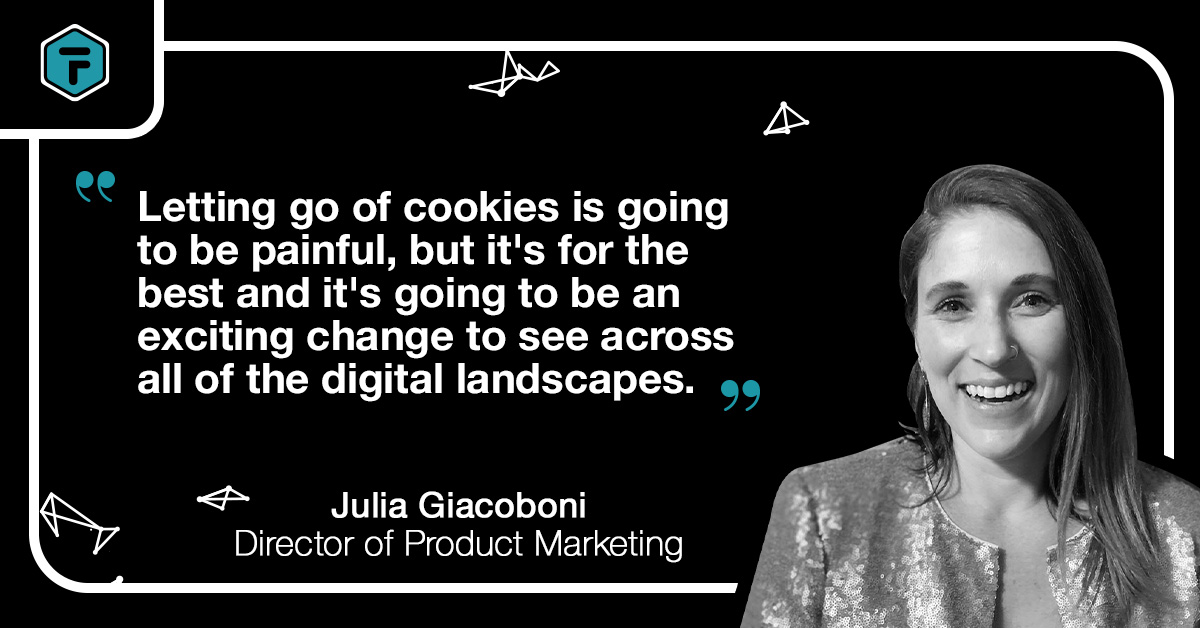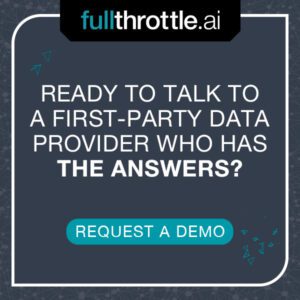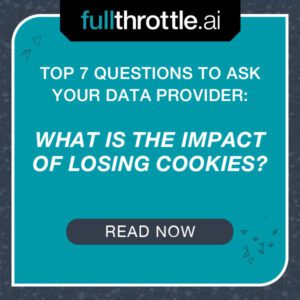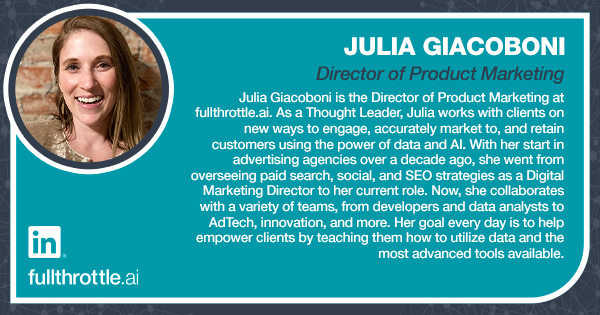
Top 7 Questions To Ask Your First-Party Data Provider
By Julia Giacoboni, Director of Product Marketing
As the use of cookies deprecates over the coming year, finding legitimate audiences to power your campaigns will become increasingly difficult. A data famine is going to sweep across the marketing space—and the clock is ticking, if you don’t have a plan in place.
This is a MAJOR change and WILL have an impact. Think about all of the touchpoints you have with cookies when you run a retargeting campaign.
Once the cookie jar goes empty, you don’t want to be stuck scrambling.
Locating data to fill the void of cookies might be easy at first thought, particularly if you have a lengthy list of customers and prospects in your database. However, when it comes to scaling your campaigns or broadening those audiences, the go-to route will need to be through a future-proof data vendor who can continue to generate and transform first-party data for you.
First-party data is different from the cookies you’re used to. It’s not ambiguous, or a list of IP addresses. It’s actual information about people who have opted in to share it.
First-party data is the gold standard—and there’s a demand for it. Everyone is rushing to figure out how to get around the demise of third-party cookies. With numerous data providers popping up, it’s critical to find a partner who is transparent, legitimate, and knowledgeable about your needs as well as the evolving first-party data space.
Feeling a little overwhelmed about where to start?
Read on for key questions to ask when looking to partner with a first-party data provider.
#1: What Is The Impact of Losing Third-Party Cookies?
You might be surprised how many products and vendors still rely on cookies. It’s easy to say you’ll go on a diet tomorrow, while you’re eating a cheesesteak today. What happens when the big day comes? What’s your plan? How are you going to cut the cord and go cold turkey?
The cookie audiences we’ve relied on to bring in new traffic will run dry, with this monumental change that stems from data concerns with personal information, CCPA, and more privacy regulations and registrations.
Before you solidify a first-party data collection plan with a vendor, you want to know what you’re looking for and what you’re getting into. It’s worth asking them for their perspective on the data landscape to ensure that they grasp the severity of this monumental shift.
If you continue banking on cookies until the bitter end, you’ll see the following items impacted:
- Scale
- Targeting
- Reporting
- Growth
Everyone talks the talk—find someone who walks the walk. You will want a vendor that understands the struggle that comes with ripping this Band-Aid off and making the switch from cookies to first-party data.
#2: What Kind of Data Am I Getting? And How Am I Getting It?
Not all data is created equally. Confirm what kind of data you can expect to get when working with a provider and how they are getting it.
Make sure that you see examples of what the data will look like on your end when you are activating it, putting it to use, and reporting with it. Get a very clear explanation of the process, where the data comes from, how they get it, and what kind of technology they are using. Stay away from IP addresses or mobile IDs—not only are cookies going away, a lot of the old ways we’ve used to target are too. Make sure their process to generate data is future-proof—you want what you’re paying for to last for the long haul.
The end goal here is to have a legitimate household that you can completely immerse in marketing for years to come.
#3: Is This Legal?
You always want to make sure that you are paying attention to the rules—especially when it comes to personally identifiable information.
Ask vendors what they have in place to make sure there is an opt-out plan for consumers and that the data is checked, validated, and audited frequently. Does it comply with the legislation, CCPA, and regulations currently in place? If they are a legitimate data provider, they should have the documents and the privacy policy ready for you to review and approve.
#4: Is the Data Clean?
Data hygiene should be top of mind. So, be sure to ask any vendor or data provider for their data maintenance process.
Do they run addresses through the NCOA system? Do they have a validation service to ensure accuracy? Are they checking with the USPS to ensure the household is a valid, occupied residence? Do they partner with any privacy management platforms?
There is a lot of effort that goes into keeping data clean and updated. If you’re paying for outdated, invalid records, they’re essentially worthless.
#5: How Do I Get the Data?
What’s the process to ingest the data and put it to use?
There should be multiple ways for you to access your data, depending on how robust or comfortable your team is with technology and the types of products/platforms you currently work with.
When you are talking to a data vendor, have them walk you through the process for your team to quickly get to the data. Whether it’s via API, an export button, or a data warehouse, ensure that it’s accessible to your team, while remaining gated and secure.
#6: How Much Work Is This Going To Be for Me?
For many technology platforms, there’s heavy lifting on the end-user's part. So, you’ll want to see how much work it will be for your team.
Make sure you know what you’re getting into—whether it’s via the API route or a CSV export. Now would be the time to train or hire people who can familiarize themselves with and own this effort—before you end up in a compromising situation that results in bad data integrity.
Using first-party data requires more attention, such as looking through the data, selecting whom you want messages to go out to, and segmenting it into different audiences. It will be more work—and someone needs to be there to help manage it. Whether it’s self-serve or turnkey/full-service, ensure you have the resources to make it work.
#7: Now What?
Lastly, it’s important to ask your data provider, “What are some of the things you can do with first-party data to help grow your business?” The process doesn’t stop at collecting it. It needs to be acted upon.
The data you’ll be using through a first-party data provider will be refined and future-proof, so you might not feel the effects of everything until you really step away from cookies.
Knowing that someone lives at 123 Main Street is really the best data you can possibly have. It’s better than an IP address or Mobile-ID. By having a physical address, you can expand that footprint beyond digital campaigning. You can push it out for display, push mail to it, run a geofencing campaign, and refine the audiences and the ads you’ve already been running. You can follow the shopper's journey and match it back to an actual transaction. With just a click on an ad, you get a truly complete loop view.
Once you’re not relying on the black box of cookies anymore, you’ll be able to follow shoppers through their entire journey, connecting to their household all along the way. You can match back to transactions, report with it, target with it, upload it into your ad platforms, and keep pushing those campaigns out!
A lot of money is on the table, if you don’t use your own first-party data.
fullthrottle.ai® Is Here to Help!
fullthrottle.ai's patented technology helps generate unique first-party household data. Our audiences enable agencies, media companies, and brands to market and measure relevant advertising down to the household. All audience solutions are available via a productized complete-loop platform or as API connections for direct integration.
To read more in this series, check them out here:
What Is The Impact of Losing Third-Party Cookies?
What Kind of Data Are You Providing Me?
How Much Work Is This Going To Be for Me?





